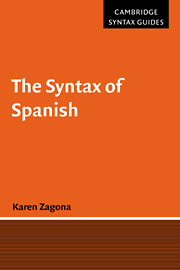3 - The Verb Phrase
Published online by Cambridge University Press: 05 June 2012
Summary
Introduction
In Chapter 2, we studied the Noun Phrase from two points of view. First, from a phrase-external perspective, we discussed the contexts in which NP is found, and introduced subtheories that account for NP distribution. We then examined the internal structure of the phrase, describing the basic structural and functional relations among constituents that co-occur with a noun to form NP (or DP). In this chapter and in Chapter 4, we will consider these same issues with respect to the Verb Phrase (VP). We will begin the discussion in this chapter with an overview of the distribution of VP, and provide a preliminary description of principles that account for this distribution (Section 3.2). We will see that there are two grammatical relations that restrict the distribution of VP: the relation between VP and the clausal subject, and the relation between VP and Tense. Subsequent sections of this chapter will be concerned with relations between the head of the phrase and its arguments. Section 3.3 discusses the external argument, or subject; Sections 3.4–3.7 describe complements or internal arguments. Although we will not provide a detailed account of the properties of verbal arguments, we will see that the subtheories introduced in Chapter 2 provide a means of structurally distinguishing verbal arguments from non-arguments. In Chapter 4, we will take up several additional issues related to the structure of the Verb Phrase, including how clitics and auxiliary verbs are related to the verb and its arguments.
- Type
- Chapter
- Information
- The Syntax of Spanish , pp. 118 - 157Publisher: Cambridge University PressPrint publication year: 2001

